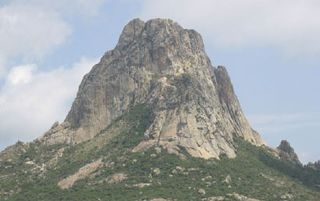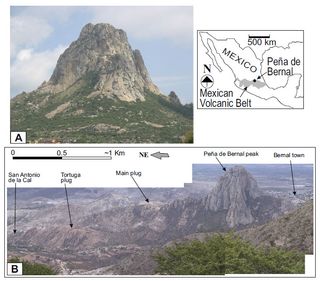
Mexican Monolith Is World's Tallest Freestanding Rock

Rising 1,421 feet (433 meters) above the North-Central Mexican state of Querétaro, Peña de Bernal Natural Monument is the tallest freestanding rock in the world.
The monolith — a large geologic feature made up of a single massive stone — marks the entrance to the Sierra Gorda, a mountainous area that the United Nations Educational, Scientific and Cultural Organization declared a Biosphere Reserve in 2001. More recently, in 2009, the rock itself was named an Intangible Cultural Heritage site by UNESCO. Yet, despite all its accolades, Peña de Bernal has largely remained a mystery to geologists; uncertainties surround its origin, its age, even its composition.
Now, a new study led by researchers at the National Autonomous University of Mexico fills many of these gaps.
The findings, published online April 4 in the journal Geosphere, include the first accurate measurement of Peña de Bernal's height, which ranks it as the tallest monolith on the planet, surpassing the Rock of Gibraltar on the Iberian Peninsula (which comes in at 1,398 feet [426 meters]) and Brazil's Sugarloaf Mountain (1,299 feet [396 meters]). Earlier guesses of Peña de Bernal’s height ranged from 945 to 1,181 feet (288 to 360 meters), and likely underestimated the true height because reaching the summit is difficult.

The monolith is composed of dacite, a type of volcanic rock; 67 percent of its bulk is silica, a mineral that is quite resistant to weathering, which explains how the peak has survived eons of wind, rain and weathering and still towers above its surroundings. The volcanic dacite formed a large dome that forcefully intruded, or pushed its way up through, the surrounding rock after the dacite dome had mostly solidified, the researchers found.
The chemical makeup of the rock hints that it formed in a subduction zone (where one tectonic plate dives below another and sinks into the mantle) near a continental margin, the researchers found. This finding makes sense, they say, because Peña de Bernal is part of the Mexican Volcanic Belt, which formed under those exact conditions.
When did all this happen? About 8.7 million years ago, the study team found. Previous estimates had put Peña de Bernal at more than 34 million years old, but chemical analyses in the current study found it to be much younger.
Sign up for the Live Science daily newsletter now
Get the world’s most fascinating discoveries delivered straight to your inbox.
Follow OurAmazingPlanet @OAPlanet, Facebook and Google+. Original article at LiveScience's OurAmazingPlanet.
Most Popular

